Hot Data Summer: Wages and Jobs, Not Interest Rates, Are Numbers to Watch Next Week
July 25, 2025
By Michael Madowitz
Next week is a busy week for economic data and news. In spite of a lot of focus on the Fed meeting Tuesday and Wednesday, with an interest rate announcement Wednesday afternoon, there’s virtually no chance of rate changes—partly because the Fed is waiting for other data, some of which we’ll get later in the week.
The first estimate of second-quarter GDP on Wednesday will be important, as will the most reliable measure of wage inflation: the Employment Cost Index (ECI) released on Thursday, before Jobs Day on Friday.
For Jobs Day, the teen employment rate is still important to keep an eye on as a proxy measure of the strength of overall demand in the economy, as I flagged last month. While June data suggested weak seasonal hiring, the July peak will be less speculative. But this month it’s also important to watch wages—for the Fed this is about potential wider signs of inflation, and for the rest of us this is about whether wages are keeping up with faster inflation as we assess the impact of tariff policy on families.
With the Consumer Price Index (CPI) indicating that tariffs are having small but growing effects on inflation, a key question for the Fed going forward is whether those price increases will spread more broadly to other prices or to wages. So far this year, wage growth has slowed, but the texture of wage growth has grown more interesting and more unusual.
For instance, the monthly measure of hourly wages from the jobs report has been volatile, making it hard to guess at overall trends in the more robust ECI. Unfortunately, ECI—which controls for changes in the mix of jobs in the economy in ways that monthly measures don’t—is released quarterly, so it will be difficult to know exactly what is happening before Thursday.
 Source: Atlanta Fed Wage Growth Tracker
Source: Atlanta Fed Wage Growth Tracker
The overall trend in wages in 2025 has been steady, but some of the most bullish post-pandemic trends have begun to wane. For example, wage growth at lower-earning jobs had outpaced high earners until summer 2024, but higher earners have seen faster gains every month since (as you can see above). In addition, as The Economist, among others, has noted, wage growth is now faster for those staying in jobs than for job switchers, a significant inversion of long-standing trends.
All and all, wage growth is painting a strange picture of an economy in neutral and potentially burdened by policy uncertainty. When that may let up is anyone’s guess—which is a reason to watch ECI and jobs numbers this month much more closely than the Fed meeting.
